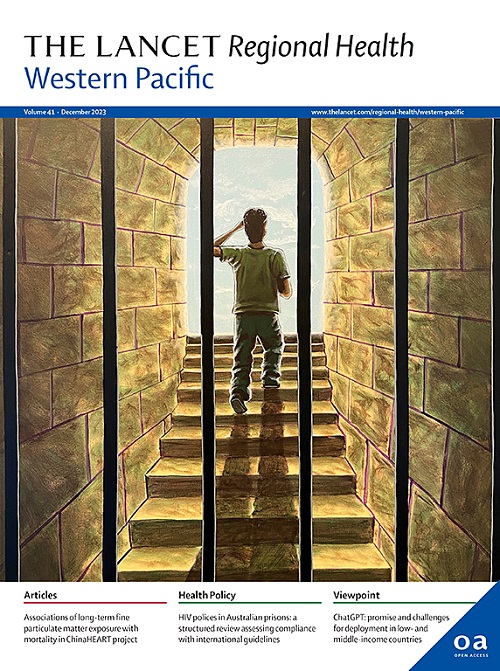Risk factors of cancer among the working population in China: baseline findings of WECAN project
IF 7.6
1区 医学
Q1 HEALTH CARE SCIENCES & SERVICES
引用次数: 0
Abstract
Background
Global cancer burden is growing rapidly, and the risk of cancer significantly increases in aged 40 and above, primarily the working population. This study aims to assess the status quo of cancer risk factors among the working population to develop targeted intervention strategies for workplace cancer prevention.
Methods
We utilized the baseline data of a randomized controlled trial “Comprehensive Workplace Intervention for Cancer Prevention in China (WECAN)” to conduct the cross-sectional analysis. 937 employees from three cities in China were surveyed on demographics, lifestyle, exposures, disease history, cancer family history, women's reproductive history, and anthropometrics.
Findings
The mean age was 40.4±8.9 years and 61.1% were males. 57.2% were blue-collars (from production workshops), while 42.8% were white-collars (from offices). The proportions of participants with junior high school or below, high school, junior college, and bachelor's degree or higher were 13.1%, 20.9%, 31.0%, and 35.0%, respectively. Overall smoking rate is 37.7%, with significantly higher rates among aged 40 and above (42.8% versus 32.1%, p<0.0001), males (59.2% versus 3.9%, p<0.0001), blue-collars (45.9% versus 26.7%, p<0.0001). Smoking rates notably increased as educational levels decreased (p<0.0001). Overall alcohol consumption rate was 62.9%, with an average alcohol intake of 12.7±20.4 g/day. Males reported a higher rate (74.7% versus 44.2%, p<0.0001) and alcohol intake (15.9±22.1 g/day versus 4.4±11.6 g/day, p<0.0001). Employees aged 40 or older consumed more alcohol (15.2±22.9 g/day versus 10.1±17.0 g/day, p=0.0020). As educational levels rose, drinking rate significantly increased (p<0.0001), while alcohol intake substantially reduced (p=0.0012). The proportion of employees who achieved 150 minutes of moderate-intensity physical activity or 75 minutes of vigorous-intensity physical activity per week was 51.9% and the average amount was 1740.2±2390.1 Mets·min. Overweight (BMI=24∼27.9 kg/m2) and obesity (BMI≥28 kg/m2) rates were 36.0% and 23.9%, with males significantly higher (40.1% versus 29.4%, 28.6% versus 16.5%, p<0.0001). Obesity increased with lower education (p=0.0007). Central obesity affected 56.0%, particularly males (66.8% versus 39.0%, p<0.0001), blue-collars (61.8% versus 48.4%, p<0.0001), aged 40 or older (61.7% versus 49.8%, p=0.0002), and lower education (p<0.0001). Daily average dietary intakes were: whole grains 48.0±80.2 g, tubers 37.8±47.3 g, vegetables 284.2±209.3 g, fruits 127.0±126.2 g, red meat 129.2±99.0 g, and processed meat 7.5±15.9 g. Males (98.4±104.2 g versus 172.0±143.6 g, p<0.0001), blue-collars (114.3±112.5 g versus 144.0±140.7 g, p=0.0005) consumed less fruits. Males (140.9±106.2 g vs 110.6±83.5 g, p<0.0001) and aged under 40 (141.2±113.7 g versus 118.2±82.2 g, p=0.0005) ate more red meat. Hepatitis B virus and helicobacter pylori virus infection rates were 3.7% and 9.8%, while the reported hepatitis B vaccination rate was 70.2%. 38.0% of the population had an exposure history to occupational hazards. Women with breastfeeding history averaged 11.0±5.5 months of cumulative breastfeeding. The cervical cancer vaccination rate is 26.7%.
Interpretation
The situation regarding cancer risk factors among working populations is severe, with high smoking and drinking rate, lack of physical activity, overweight/obesity, unhealthy diet and low vaccination rates for cervical cancer and hepatitis B. Significant disparities across demographic groups were found. These findings highlight areas for cancer prevention through targeted approaches in the workplace.
求助全文
约1分钟内获得全文
求助全文
来源期刊

The Lancet Regional Health: Western Pacific
Medicine-Pediatrics, Perinatology and Child Health
CiteScore
8.80
自引率
2.80%
发文量
305
审稿时长
11 weeks
期刊介绍:
The Lancet Regional Health – Western Pacific, a gold open access journal, is an integral part of The Lancet's global initiative advocating for healthcare quality and access worldwide. It aims to advance clinical practice and health policy in the Western Pacific region, contributing to enhanced health outcomes. The journal publishes high-quality original research shedding light on clinical practice and health policy in the region. It also includes reviews, commentaries, and opinion pieces covering diverse regional health topics, such as infectious diseases, non-communicable diseases, child and adolescent health, maternal and reproductive health, aging health, mental health, the health workforce and systems, and health policy.
 求助内容:
求助内容: 应助结果提醒方式:
应助结果提醒方式:


